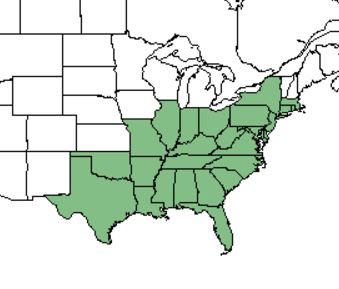Difference between revisions of "Ilex opaca"
KatieMccoy (talk | contribs) |
KatieMccoy (talk | contribs) |
(No difference)
| |
Revision as of 19:37, 7 January 2016
| Ilex opaca | |
|---|---|
Error creating thumbnail: Unable to save thumbnail to destination
| |
| Scientific classification | |
| Kingdom: | Plantae |
| Division: | Magnoliophyta - Flowering plants |
| Class: | Magnoliopsida - Dicotyledons |
| Order: | Celastrales |
| Family: | Aquifoliaceae |
| Genus: | Ilex |
| Species: | I. opaca |
| Binomial name | |
| Ilex opaca Aiton | |

| |
| Natural range of Ilex opaca from USDA NRCS Plants Database. | |
Common name: American holly
Contents
Taxonomic notes
Description
I. opaca is a upright evergreen tree that is commonly known as the Christmas holly. It is the only native holly in the U.S. to have spiny green, leathery leaves and bright red berries [1]. The fine-textured wood is ideal for inlays in cabinetwork, carvings and vanier [2].
Distribution
Ecology
Habitat
Ideal habitats are moist, acidic, well-drained soils such as mesic hammocks, sand pine-oak woods, bordering floodplains, deciduous woodland on limestone, and mesic steepheads (FSU Herbarium). Soils include sandy loam, loam, medium loam, and does not favor well in clay<ref name="wildflower">(FSU Herbarium).
Phenology
Seed dispersal
Seed bank and germination
Fire ecology
Pollination
The following Hymenoptera families and species were observed visiting flowers of Ilex opaca var. arenicola at Archbold Biological Station (Deyrup 2015):
Apidae: Apis mellifera, Bombus impatiens
Colletidae: Colletes banksi, C. brimleyi
Halictidae: Augochloropsis metallica, Augochloropsis sumptuosa
Megachilidae: Megachile petulans
Sphecidae: Cerceris rozeni, Gorytes dorothyae ruseolus, Hoplisoides denticulatus denticulatus, H. placidus placidus, Liris argentata, L. muesebecki, Pseudoplisus smithii floridanus, Tachysphex apicalis, T. similis, Tanyoprymnus moneduloides
Vespidae: Pachodynerus erynnis
Use by animals
Diseases and parasites
Conservation and Management
Cultivation and restoration
Photo Gallery
References and notes
Deyrup, M.A. and N.D. 2015. Database of observations of Hymenoptera visitations to flowers of plants on Archbold Biological Station, Florida, USA.